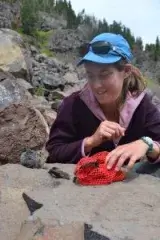Featured Data
Annual Point Count Breeding Bird Survey at Pepperwood Preserve in the California Coast Ranges 2007-2019
September 1, 2020
Susanne Grossman-Clarke
Citation
Halbur, M.M., T.L. Comendant, N. Barden, A.L. Whipple, and E. Micheli. 2020. Annual Point Count Breeding Bird Survey at Pepperwood Preserve in the California Coast Ranges 2007-2019 ver 1. Environmental Data Initiative. https://doi.org/10.6073/pasta/65b2df11b736c5b51d5fad90dc4a08e9.
Description
The Dwight Center for Conservation Science at Pepperwood is an ecological institute dedicated to educating, engaging, and inspiring our community through habitat preservation, science-based conservation, leading-edge research, and interdisciplinary educational programs. Our mission is to steward the life and landscapes of the 3,200-acre Pepperwood Preserve and to advance science-based conservation of ecosystems throughout our region and beyond.
The Pepperwood Breeding Bird Survey was initiated in the spring of 2007 with the goal of establishing a set of baseline bird community data that would be built upon for years to come. Four transects (totaling 38 points) are surveyed annually using standardized five-minute point count protocols outlined by the Point Reyes Bird Observatory (now called Point Blue Conservation Science; Ballard et al. 2003) and the Handbook of Field Methods for Monitoring Landbirds (Ralph et al. 1993). Surveys are conducted by experienced volunteers during the breeding season starting in late April and ending in June, with each transect surveyed a total of three times. The Rogers Creek and Martin Creek transects were established in 2007. The Weimar Flat and Pepperwood Road transects were established in 2008 and 2012, respectively, to ensure comprehensive coverage across the various habitats that occur at the preserve including Douglas-fir forest, mixed hardwood forest, oak woodland/forest, chaparral, and open grasslands. This dataset includes data collected between 2007-2019.

This featured data package was published by our 2020 Summer Fellow with the Pepperwood Preserve, Ashley Whipple. Ashley says “For many, data management is not part of the job as volunteers or field technicians. However, the steps between compiling the data and sharing it with the public takes a lot of effort and is a large part of a scientist’s job. This summer I learned what it takes to clean, organize, and archive data for public use. I had the pleasure of training with the Environmental Data Initiative (EDI) and working with the Pepperwood Foundation as a fellow.” Read more in Ashley’s blog post on her fellowship experience “My data’s data: a metadata story”.